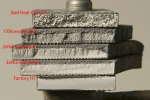So I'm new to knife making and pretty new to the forum. I've made a few railroad spike knives that I'm pretty happy with. I recently scavenged several lathe tailstock centers that I thought could make pretty good knives. I believe they are 52100. I decided to make a test knife so I could see the results of my process. I started by attempting to anneal it by heating it to non magnetic and plunging it into a preheated can of sand to cool slowly. I read that 52100 likes to crack if forged too cold so I tried to maintain heat while forging. After forging and some rough grinding I normalized by again heating to non magnetic and allowing to air cool. I then heat treated by heating yet again to non magnetic and quenching in preheated soy oil (it was cheap). I tried to keep everything simple because I have a primitive forging set up and I want to be able to reliably reproduce these results.
Here's a link to a handful of very short testing videos. I might be throwing myself to the wolves here but I'd appreciate any feedback.
https://icedrive.net/1/37Oj9vupnq
Here's a link to a handful of very short testing videos. I might be throwing myself to the wolves here but I'd appreciate any feedback.
https://icedrive.net/1/37Oj9vupnq

